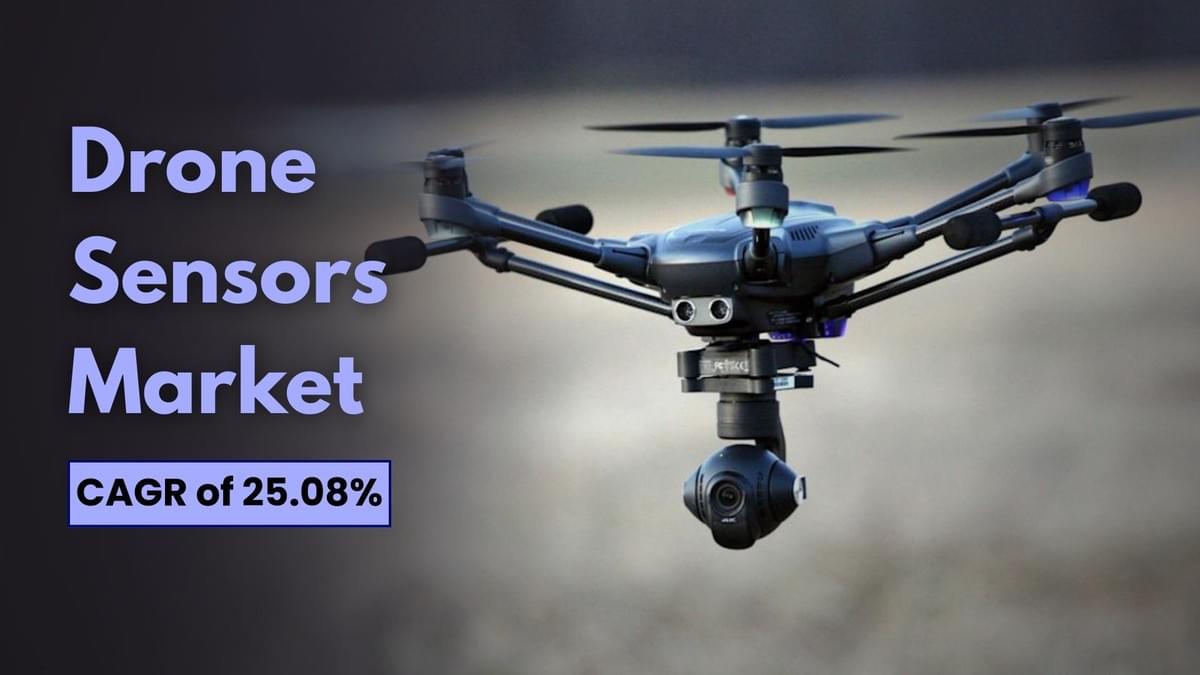According to Fortune Business Insights™, the global drone sensors market was valued at USD 394.7 million in 2020 and is projected to reach USD 2,342.1 million by 2028, exhibiting a strong CAGR of 25.08% during the forecast period (2021–2028). Growth is being propelled by the increasing integration of unmanned aerial systems (UAS) across both defense and commercial applications worldwide.
Market Overview
The drone sensors market is gaining significant momentum, fueled by the rising adoption of UAVs in industries such as agriculture, logistics, aerial imaging, public safety, and defense. Drones depend on a wide range of sensors—including image, inertial, pressure, and distance sensors—to achieve precise navigation, stable flight, and accurate real-time data capture.
The demand for high-performance sensors has escalated as industries seek smarter, more autonomous operations. Advanced sensor systems enable drones to execute long-range flights, precision imaging, and enhanced surveillance, making them indispensable across both commercial and defense operations.

Market Drivers
Rising Military Adoption of Unmanned Systems
Military forces worldwide are rapidly adopting unmanned systems for intelligence, surveillance, reconnaissance, and targeting (ISRT) missions. According to SIPRI, global defense spending exceeded USD 1.9 trillion in 2019 and continues to grow. Modernization programs increasingly emphasize UAV procurement, driving the demand for advanced sensors such as infrared, LiDAR, pressure, and inertial sensors for precise operations.
The growing integration of artificial intelligence into drone automation is further expected to accelerate market expansion.
Expanding Commercial Applications
Drones are revolutionizing industries through applications like aerial photography, delivery services, precision farming, and infrastructure monitoring. According to Goldman Sachs, drones could create opportunities worth USD 11 billion in the construction sector and USD 5.9 billion in agriculture.
Precision farming—enabled by multispectral and thermal imaging sensors—supports soil monitoring, crop health assessment, and pesticide spraying, significantly improving yields. These advancements are set to propel commercial drone adoption, creating strong demand for advanced sensor systems.
Restraining Factors
Despite strong growth, challenges remain. Drone sensors are sensitive to extreme environmental conditions, which may cause performance issues in harsh climates. Moreover, the high cost of advanced sensor systems—due to complex circuit designs and dependencies on multiple technologies—remains a barrier for wider adoption, particularly in cost-sensitive markets.
Information Source:
https://www.fortunebusinessinsights.com/drone-sensor-market-102596
Segmentation Analysis
By Sensor Type
The drone sensors market is segmented into inertial sensors, image sensors, speed & distance sensors, position sensors, and other sensor categories such as pressure, altimeter, ultrasonic, current, and light sensors. Inertial sensors include accelerometers, gyroscopes, tilt sensors, and magnetometers, and are projected to generate USD 312.5 million by 2025. Meanwhile, image sensors—covering thermal, infrared, and multispectral technologies—are expected to record the highest CAGR through 2028, primarily due to their increasing use in aerial photography and advanced imaging applications. Speed and distance sensors include radar, LiDAR, and proximity solutions, while position sensors rely on GPS and GNSS technologies to ensure accurate navigation. These diverse sensors collectively form the backbone of UAV functionality by enabling precise navigation, mapping, and operational stability.
By Platform
In terms of platform, the market is categorized into VTOL, fixed-wing, and hybrid systems. The fixed-wing segment dominated in 2020, largely because of its extensive use in military operations, including mapping, surveillance, and intelligence gathering, where advanced sensors are essential for reliable data collection. However, the VTOL segment is expected to register the highest CAGR during the forecast period as demand rises in commercial logistics applications such as food delivery, parcel distribution, medical supply transport, and sample collection. VTOL drones held a 29.7% market share in 2020, reflecting their growing versatility and adaptability across industries. Hybrid systems, which combine features of both fixed-wing and VTOL drones, are also gaining traction for their ability to support long-range missions with greater efficiency.
By Application
Based on application, the market is segmented into navigation, collision detection & avoidance, data acquisition, motion detection, air pressure measurement, power monitoring, and other functions. Among these, the navigation segment dominates the market and is projected to account for 29% of the share by 2025. This strong positioning is attributed to the widespread reliance on GPS and advanced mapping systems that enable drones to operate in complex environments with high accuracy. Navigation sensors are particularly critical in emergency applications such as disaster management, search & rescue operations, and remote sensing, where precision in positioning and direction is vital. Meanwhile, applications such as collision detection, motion sensing, and power monitoring continue to grow in importance as drone operations expand across both commercial and defense sectors.
Regional Insights
- North America: Valued at USD 143.2 million in 2020, leading the market with strong defense spending and commercial drone adoption in the U.S. and Canada. Smart agriculture applications also drive growth.
- Europe: Expected to grow at a 24.57% CAGR, supported by demand in Germany, France, and Russia for commercial drones.
- Asia Pacific: Anticipated to record healthy growth due to rising military spending in China, India, and Japan. China is projected to grow at 25.33% CAGR, while Japan’s drone sensor market is set to reach USD 48.79 million by 2025.
- Rest of the World: Holds a smaller share due to limited UAV procurement, but opportunities exist in emerging markets.
Key Players
The market is moderately fragmented, with global leaders and emerging players competing through product innovation and strategic investments.
Leading Companies:
- Trimble (U.S.)
- Bosch Sensortec (Germany)
- TDK InvenSense (U.S.)
- Sparton NavEx (U.S.)
- Raytheon (U.S.)
- AMS AG (Austria)
- Flir Systems (U.S.)
- KVH Industries (U.S.)
- TE Connectivity (Switzerland)
- Lord MicroStrain (U.S.)
Strategic Moves:
- In November 2020, the U.S. Department of Defense awarded USD 93.3 million to General Atomics for developing advanced sensors for the MQ-9 Reaper under the Smart Sensor Project, integrating AI-driven object recognition for improved autonomous control.
No responses yet